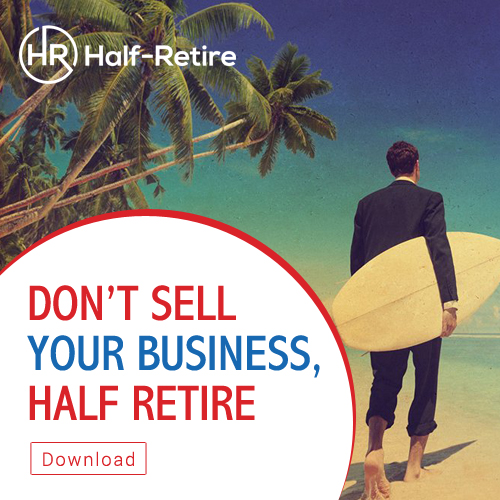Don’t Sell Your Business, Half-Retire
Why do people sell their businesses? To secure their financial future, lose the stress of running a business, and free up time to pursue other activities, right?
But many business owners are stuck with a difficult situation – the amount they can sell the business for will not fully- fund their future. Learn more on the free webinar.
Here is what we hear from business owners:
- The business may not be worth enough to allow me to retire (value gap).
- Even if I cash out, what will I invest in? The stock market seems volatile.
- I don’t know what I will do with myself if I retire.
- I still like the work.
- What happens to my employees when I’m gone?
Traditionally, entrepreneurs have used conventional solutions to solve this issue:
- Close the value gap so the math works (like you haven’t been trying up until now?).
- Sell the business for what you can get and trust the stock market.
- Learn to enjoy golf.
- Don’t worry about your people. They will be fine.
Half-Retirement©
Lately, we have seen a trend towards not selling the business but radically reducing the workload and keeping the income. We call this:
We love this trend as it solves a previously unsolvable problem, bridging the value gap. Here is how we define the goals of Half-Retirement© : Create a business that allows you to . . .
- Work half a day every other day
- Do only the work you enjoy
- Maintain your current income level
- Keep the business asset to sell later or give to your employees/kids.
Let’s not kid ourselves. No big initiative such as Half-Retirement© is easy. To accomplish the goal you will need to embrace three philosophical shifts and complete an eight-phase action plan.
Philosophical shift #1…move from working income to equity income
Most business owners earn money by:
- 1. Having a “job” in the business such as salesperson, manager, etc.
- 2. Doing the high-variety work that’s hard to delegate.
- 3. Serving as the key manager or leader.
- 4. Doing high-value entrepreneurial work such as strategy, planning, relationship-building, etc.
- 5. Earning a return on their invested capital.
- Items 1, 2, and 3 have got to go.
Philosophical shift #2…it’s not your presence that makes a difference, it’s your Picasso work
What does it take to make a painting a Picasso? Only the brush touched to the canvas by the artist. Every other activity does NOT require the special genius of Picasso. You too have special genius. You will need to boil your special genius down to its essence.
Philosophical shift #3…it’s not your people you will need to trust, it’s your systems
Business owners hate imperfection and systems are inflexible. This makes them 99% perfect, not 100%, so we default to people-based systems. The problem with people-based systems is they are employee-dependent. This means your employees own your systems, not you , it creates unpredictability, and systems leave when employees leave.
Blueprint for Half-Retirement©
Most business owners take one year to complete the phases. Remember, it took years to create your business; you won’t be able to create a viable exit plan over a weekend. Sorry.
Below are the eight phases to the Half-Retirement© Plan:
- Phase 1: Discover your Picasso work
- Phase 2: Use a process (e.g. 98/2) to shift lower-value work to the team
- Phase 3: Shift from owner-driven enterprise to employee-driven enterprise
- Phase 4: Create a “this is how we do things” culture so you do not need to be the standard bearer
- Phase 5: Create a strong second in command
- Phase 6: Strengthen systems so the systems run the business and the people run the systems (and not the other way around)
- Phase 7: Create tight financial controls to protect your income
- Phase 8: Enjoy the spoils of Half-Retirement



By shifting your focus from selling the business to running it differently, you can extract much more value from all the hard work you have put into your business.

Disclaimer: CEO Focus cannot guarantee any business results. Our goal is to share best practices we observe in the marketplace and share those with the business community. Since every business and every business owner is different, results will vary significantly. What worked for one business owner may not work at all for another. Please use any information on our website as suggestions and observed best practices. All important business decisions should be run by your profession advisors.




